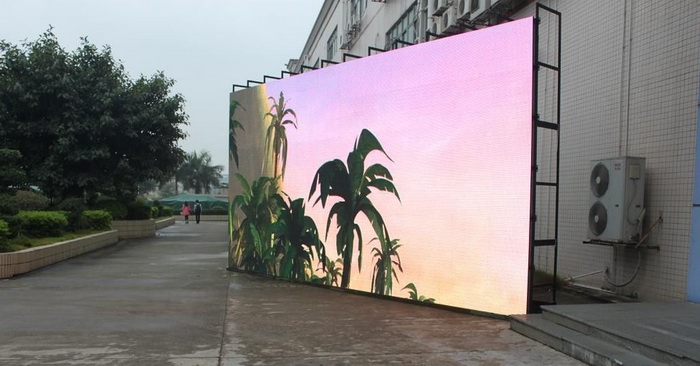Tag: LED displays heat dissipation, LED outdoor full-color billboard, Shenzhen LED screen manufacturers


As the awareness of environmental protection rose greatly, energy-saving has already become the development trend of the current society. LED industry is one of the most high-profile industries in recent years. After long time development, the LED products have the advantages of energy saving, power saving, high efficiency, fast response time, long life cycle, no mercury and environment friendly; However, most of the input power of LED high power products about 20% turned into light and the remaining 80% of the electricity energy are converted into heat energy.
Generally speaking, if the heat energy could not exported, the service life, luminous efficiency and stability of the products could be affected due to the overheat of LED junction panel thus affects the product life cycle, luminous efficiency, stability. We will use the diagram below to show you the relationship between LED junction temperature and luminous efficiency and service life.
1. Ways of heat dissipation
According to different packaging technology, the cooling method is also different and some simple heat dissipation ways of LED can be as followed:
The cooling ways:
(1). Heat from the air
(2). Direct heat by Systemcircuitboard export
(3). Through the gold thread to heat the export
(4). If the eutectic and Flip chip process, the heat through the hole to the system circuit board and the export
In general, the LED grain (Die) use gold wire or eutectic or flip chip to connected with the substrate (Substrate of LED Die) and form a LED chip (chip), then the LED chip is fixed on the system of the circuit board (System circuit board). The possibility of LED heat dissipation ways could be direct dissipated through air, or dissipated through LED grain substrate to the system circuit board and led to the atmospheric environment. The rate of heat dissipation is determined by the whole lamps and the design of the system.
However, the bottleneck is mainly on the process of dissipation from substrate of LED die to its substrate and then to system circuit board. The possible way of heat dissipation is from substrate of LED die to system circuit board. In this process, the heat dissipation capacity of substrate material of LED die is an important parameter. On the other hand, the heat produced by LED would pass to system circuit board from electrode wire. Commonly, heat dissipation is limited by the elongated shape of gold wire when using it joint electrode. Therefore, using eutectic or flip chip to joint could reduce the length and increase the cross-sectional area of the wire which could greatly improve the heat dissipation effect.
In a word, the chose of LED radiating substrate material and encapsulation of LED die are vital to LED heat dissipation management.
2. LED cooling substrate
LED cooling submount takes advantage of the high thermal conductivity of the submount material to export heat source from LED dies. It could be divided into LED crystal substrate and system circuit board. The two different cooling substrates loaded LED crystal grains and LED chips separately which export the heat dissipation from substrate of LED die to system via the LED circuit board to achieve cooling effect.
2.1 System circuit board
The system circuit board mainly used in the LED heat dissipation ,at last the thermal energy relieved to the cooling fins, shell, or the material in air. Recently the production technology of PCB has got mature. With the increasing demand for high power LED, it cannot apply to its high power products due to the limited heat dissipation capacity of its material. In order to improve this, MCPCB was invented, which use the feature that metal material can relieve heat well. Although system circuit board could export the heat produced by LED chips to the air, the heat produced by LED dies cannot exported effectively form dies to system circuit board. In other words, as the LED power gets more efficient, the bottleneck of the heat dissipation would be on substrate of LED die.
2.2 LED grain substrate
LED grain substrate is the medium of heat energy export between LED dies and system circuit board, which combined to LED dies under the process of wire bonding, eutectic or flip chip.
Considering the heat dissipation, currently LED grain substrate is mainly dominated by the ceramic substrate on the market, which could be divided into thick film & thin film ceramic substrate and low temperature co-fired ceramic(LTCC). Traditional LED elements mainly are thick ceramic substrate and LTCC, and then combined with gold wire bonding of LED dies.
Verypixel High Quality LED Display Products


As presented before, the gold wire bonding lowers the lost of heat energy along the electrode joint. In recent years, the whole industry is working for a solution of this problem. There are two solutions. One of them is looking for PCB material of high heat dissipation coefficient to displace alumina. They are silicon substrate, silicon carbide substrate, anodized MCPCB and aluminum nitride substrate. Silicon substrate and silicon carbide substrate are under harsh tests due to the characteristics of semiconductor material. Anodized MCPCB is restricted in practical application because the lack of strength of anodic oxidation film, which would lead to break over. Therefore, aluminum nitride substrate is using widely. Its circuit should backup under the process of thin film because it is not applicable to traditional thick film (the material should undergo 850°C controlled atmosphere after silver printing ).

Page address: http://www.verypixel.com/blog/LED_Heat_Dissipation_Substrate_Board.html